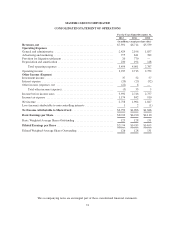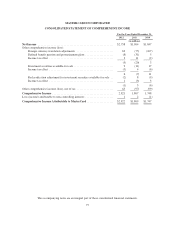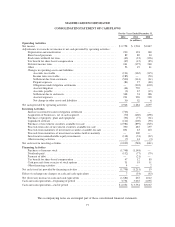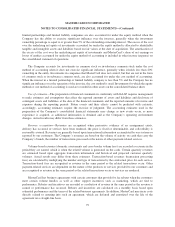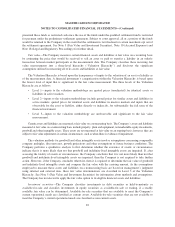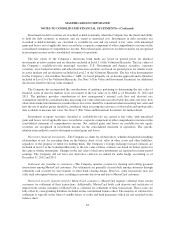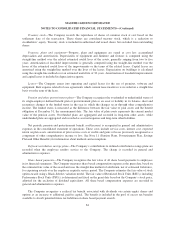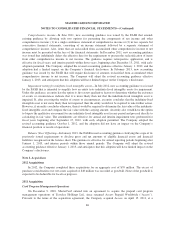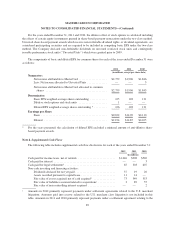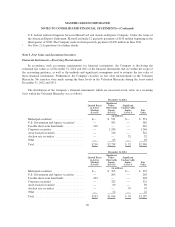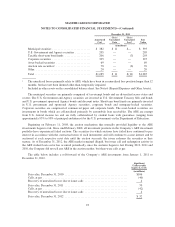MasterCard 2012 Annual Report Download - page 88
Download and view the complete annual report
Please find page 88 of the 2012 MasterCard annual report below. You can navigate through the pages in the report by either clicking on the pages listed below, or by using the keyword search tool below to find specific information within the annual report.MASTERCARD INCORPORATED
NOTES TO CONSOLIDATED FINANCIAL STATEMENTS—(Continued)
Treasury stock—The Company records the repurchase of shares of common stock at cost based on the
settlement date of the transaction. These shares are considered treasury stock, which is a reduction to
stockholders’ equity. Treasury stock is included in authorized and issued shares but excluded from outstanding
shares.
Property, plant and equipment—Property, plant and equipment are stated at cost less accumulated
depreciation and amortization. Depreciation of equipment and furniture and fixtures is computed using the
straight-line method over the related estimated useful lives of the assets, generally ranging from two to five
years. Amortization of leasehold improvements is generally computed using the straight-line method over the
lesser of the estimated useful lives of the improvements or the terms of the related leases. Capital leases are
amortized using the straight-line method over the lives of the leases. Depreciation on buildings is calculated
using the straight-line method over an estimated useful life of 30 years. Amortization of leasehold improvements
and capital leases is included in depreciation expense.
Leases—The Company enters into operating and capital leases for the use of premises, software and
equipment. Rent expense related to lease agreements which contain lease incentives is recorded on a straight-line
basis over the term of the lease.
Pension and other postretirement plans—The Company recognizes the overfunded or underfunded status of
its single-employer defined benefit plan or postretirement plan as an asset or liability in its balance sheet and
recognizes changes in the funded status in the year in which the changes occur through other comprehensive
income. The funded status is measured as the difference between the fair value of plan assets and the benefit
obligation at December 31, the measurement date. The fair value of plan assets represents the current market
value of the pension assets. Overfunded plans are aggregated and recorded in long-term other assets, while
underfunded plans are aggregated and recorded as accrued expenses and long-term other liabilities.
Net periodic pension and postretirement benefit cost/(income) is recognized in general and administrative
expenses in the consolidated statement of operations. These costs include service costs, interest cost, expected
return on plan assets, amortization of prior service costs or credits and gains or losses previously recognized as a
component of other comprehensive income or loss. See Note 11 (Pension Plans, Postretirement Plan, Savings
Plan and Other Benefits) for information about methods and assumptions.
Defined contribution savings plans—The Company’s contributions to defined contribution savings plans are
recorded when the employee renders service to the Company. The charge is recorded in general and
administrative expenses.
Share based payments—The Company recognizes the fair value of all share based payments to employees
in its financial statements. The Company measures share based compensation expense at the grant date, based on
the estimated fair value of the award and uses the straight-line method of attribution, net of estimated forfeitures,
for expensing awards over the employee requisite service period. The Company estimates the fair value of stock
option awards using a Black-Scholes valuation model. The fair value of Restricted Stock Units (RSUs), including
Performance Stock Units (PSUs), is determined and fixed on the grant date based on the Company’s stock price,
adjusted for the exclusion of dividend equivalents. All share based compensation expenses are recorded in
general and administrative expenses.
The Company recognizes a realized tax benefit associated with dividends on certain equity shares and
options as an increase to additional paid-in capital. The benefit is included in the pool of excess tax benefits
available to absorb potential future tax liabilities on share based payment awards.
84


